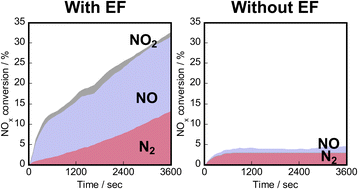Electric field-assisted NSR process for lean NOx reduction at low temperatures†
Abstract
Lean-burn engines are gaining attention for their lower CO2 emissions, higher thermal efficiency, and improved fuel economy compared to traditional combustion engines. However, they present some difficulty for reducing nitrogen oxides (NOx) because of residual oxygen. To address this difficulty, NOx storage reduction (NSR) system, which combines noble metals and NOx adsorbents, is developed as a viable approach. But it requires cyclic operation, which adversely affects fuel efficiency. A novel approach proposed in this work is electric field-assisted lean NOx reduction, which applies an electric field to the NSR catalyst during lean conditions. This innovation uses surplus vehicle electricity for exhaust purification, enhances hydrogen transfer, and improves NOx reduction, even at low temperatures. Tests with a 3 wt% Pt–16 wt% BaO/CeO2 catalyst demonstrate markedly higher NOx conversion to N2 (13.1% vs. 2.9% without an electric field). This process is effective with extended electric field exposure, doubling the conversion rate. Electric field-assisted lean NOx reduction, by improving NSR technology, can enhance NOx conversion efficiency, reduce emissions, and optimize fuel efficiency in lean-burn engines.



 Please wait while we load your content...
Please wait while we load your content...